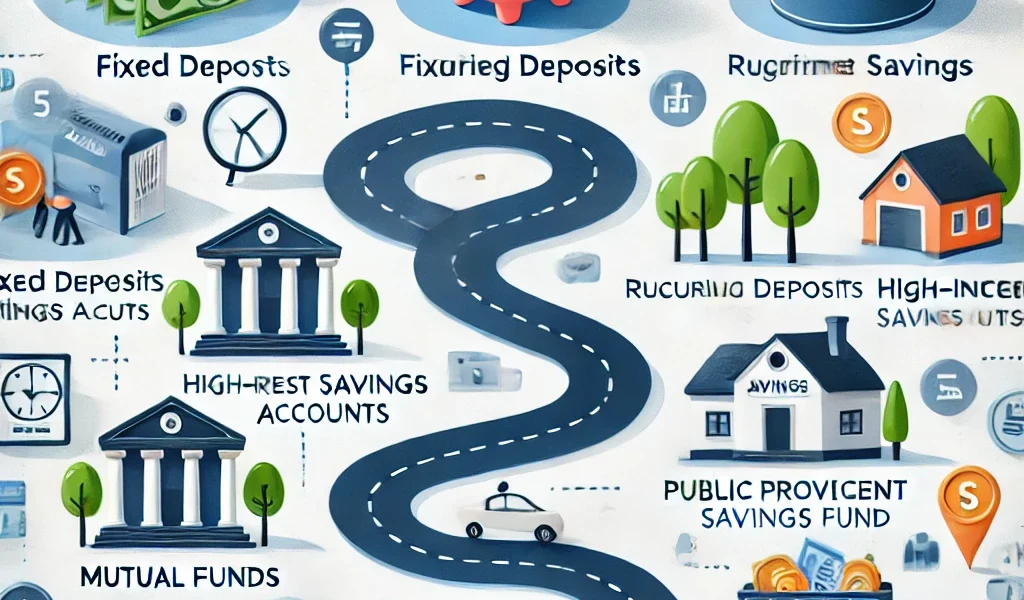Introduction
Saving money is an essential part of financial planning, but choosing the right saving plan can be overwhelming. With numerous options available, selecting the best one depends on your financial goals, risk tolerance, and time horizon. This guide will help you understand different saving plans and how to pick the right one to achieve financial security.
Understanding Your Financial Goals
Before selecting a saving plan, you need to define your financial goals. Your objectives will determine the best saving strategy. Common financial goals include:
- Short-Term Goals (1-3 years): Emergency fund, vacation, home renovation.
- Medium-Term Goals (3-10 years): Buying a house, children’s education, starting a business.
- Long-Term Goals (10+ years): Retirement, wealth creation, financial independence.
Types of Saving Plans
Different saving plans cater to various financial needs. Here are some of the most popular options:
1. Fixed Deposits (FDs)
- Suitable for risk-averse individuals.
- Provides a fixed interest rate over a set tenure.
- Ideal for medium-term financial goals.
2. Recurring Deposits (RDs)
- Allows monthly contributions with a fixed tenure.
- Ideal for disciplined saving habits.
- Suitable for short- to medium-term goals.
3. High-Interest Savings Accounts
- Provides liquidity and higher interest than regular savings accounts.
- Best for emergency funds and short-term savings.
4. Public Provident Fund (PPF)
- Long-term government-backed scheme with tax benefits.
- Lock-in period of 15 years, suitable for retirement planning.
5. National Savings Certificate (NSC)
- Fixed-income investment with tax benefits.
- Ideal for medium-term savings and wealth accumulation.
6. Sukanya Samriddhi Yojana (SSY)
- Designed for girl child savings with tax-free returns.
- Long-term plan for education and marriage expenses.
7. Mutual Funds (Systematic Investment Plans – SIPs)
- Market-linked investment with potential higher returns.
- Suitable for long-term financial goals with moderate risk appetite.
8. Employee Provident Fund (EPF) & Voluntary Provident Fund (VPF)
- Employer-sponsored retirement savings with tax benefits.
- Best for salaried individuals looking for long-term security.
9. Gold Savings Schemes
- Ideal for individuals planning future gold purchases.
- Provides a hedge against inflation.
10. Government Bonds & Post Office Saving Schemes
- Low-risk investment options with guaranteed returns.
- Suitable for retirees and conservative investors.
Factors to Consider When Choosing a Saving Plan
- Time Horizon: Short-term goals require liquid and secure investments, while long-term goals can accommodate higher-risk plans.
- Risk Appetite: Conservative investors should opt for fixed deposits, government-backed schemes, or savings accounts, while aggressive investors may consider mutual funds or stocks.
- Liquidity Needs: If you need easy access to funds, high-interest savings accounts or recurring deposits are better than long-term locked-in investments.
- Tax Benefits: Some savings schemes, like PPF and NSC, offer tax deductions that can help reduce taxable income.
- Interest Rates and Returns: Compare the interest rates offered by different plans to maximize your savings.
- Inflation Protection: Consider whether the plan provides returns that can beat inflation over time.
- Diversification: A mix of different saving plans can help balance risk and returns, ensuring financial stability.
Step-by-Step Guide to Choosing the Right Saving Plan
- Define Your Goals: Identify the purpose of saving and set clear financial targets.
- Assess Your Financial Situation: Evaluate your income, expenses, and existing savings.
- Compare Different Options: Research various saving plans, their features, and benefits.
- Consider Professional Advice: Consult a financial advisor if needed.
- Start Saving Early: The earlier you start, the more you benefit from compounding interest.
- Monitor and Adjust: Regularly review your savings strategy to align with changing financial goals.
Conclusion
Choosing the right saving plan depends on your financial goals, risk tolerance, and investment horizon. Whether you’re saving for an emergency fund, a child’s education, or retirement, selecting a suitable saving plan will help you achieve financial stability and growth. By understanding the available options and considering key factors, you can make an informed decision and build a strong financial future.




